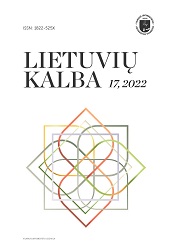Tauragės zonos tarmiškumas: tarminių požymių realizacijos pokyčiai (XX a. antroji pusė – XXI a. antrasis dešimtmetis)
Dialecticism in the Tauragė zone: the changing realization of dialectal features (from the second half of the 20th century to the 2010s)
Author(s): Diana DambrauskienėSubject(s): Historical Linguistics, Sociolinguistics, Baltic Languages
Published by: Vilniaus Universiteto Leidykla
Keywords: Southern Žemaitian in Raseiniai; subdialect; Tauragė zone; dialecticism; dialecticism value; dialecticism score;
Summary/Abstract: Mobility and interaction with speakers of other (sub)dialects are two of the most important factors driving the change in the Southern Žemaitian subdialect of Raseiniai. Movement towards more socioculturally and infrastructurally stronger locations within the neighbouring (sub)dialects (Western Žemaitian, Southern Žemaitian of Varniai, Western Aukštaitian of Kaunas) has caused the formation of a separate zone in the south-western part of the Southern Žemaitian subdialect of Raseiniai. Characterised by communicational links, this zone includes 15 points of the „Atlas of the Lithuanian Language“ (Lietuvių kalbos atlasas; hereinafter – LKA): Vainùtas (LKA 356), Žviñgiai (LKA 357), Pãgramantis (LKA 358), Lomiai (LKA 359), Batakiai (LKA 360), Skaudvilė (LKA 361), Petkáičiai (LKA 362), Žygáičiai (LKA 390), Jociai (LKA 391), Stragùtė (LKA 392), Jõniškė (LKA 393), Pašaltuonỹs (LKA 394), Er̃žvilkas (LKA 395), Rūgãliai (LKA 463) ir Eičiai (LKA 464). The migration of Žemaitian communities prompted the formation of a transitional Taurage geolect. A three-generational study of dialecticism in the area confirms intense changeability and variability of dialectal features – the characteristics of a transitional geolect. This article analyses the realization of dialectal features in the Southern Žemaitian subdialect of Raseiniai based on dialectal texts collected during the second half of the 20th century and the sound recordings obtained during the 2010s. This data was collected from seven LKA points within the Taurage zone (Vainùtas (LKA 356), Žviñgiai (LKA 357), Pãgramantis (LKA 358), Lomiai (LKA 359), Skaudvilė (LKA 361), Žygáičiai (LKA 390), and Jociai (LKA 391)) deemed to be most representative of the subdialect in the 20th century. When the realization of dialectal features during these two periods was compared, differences were found not only in terms of the time segment but also within virtually all LKA points and fragments of dialectal materials supplied by every respondent. The average dialecticism scores show that the residents of the Taurage zone spoke the traditional variant of the subdialect (dialectal speech) in the second half of the 20th century but moved towards a less traditional variant by the 2010s. This is also summarised and confirmed in the diagrams of dialecticism values. During the research, differences between the minimum and maximum limits of dialecticism were identified and the range of dialecticism indexes was determined. The results prove that the Taurage zone has been dialectally heterogenous since the second half of the 20th century. In just over sixty years the area has experienced a rather dynamic transition from dialect speech to the less traditional variant. Therefore, a greater degree of variation across the dialecticism scores of the sound recordings, compared to those observed in the text fragments, leads to the conclusion that the change in the subdialect is becoming increasingly faster in the 21st century due to the processes of convergence.
Journal: Lietuvių kalba
- Issue Year: 2022
- Issue No: 17
- Page Range: 92-108
- Page Count: 17
- Language: Lithuanian

